Welcome to the digital age, where static text won’t cut it anymore!
If you want to leave your competitors in the dust and captivate your audience’s attention – time to embrace the power of interactive content. Captivating quizzes, eye-catching polls, immersive surveys – interactive media is the key to keeping your users engaged and coming back for more.
In this blog post, let’s dive into the world of interactive content, exploring its types and real-life examples that’ll inspire you to take your digital game to the next level.
Interactive Content Definition
Hold on, what exactly is interactive content? We’d like to name it a digital playground that invites you to play and engage, but if we’re going into serious terms – interactive content is the content where you can actively participate, navigate and get instant feedback on your actions.
Think of interactive quizzes, polls, games, videos – you name it. Whether you’re learning something new, exploring products, or just having fun, interactive content keeps you hooked and entertained.
One of the best interactive content examples is Netflix’s movie Black Mirror: Bandersnatch. In the movie, you can make choices that influence the character’s decisions and shape the storyline.

Why Use Interactive Content and What Are the Benefits?
Interactive content might really help with user engagement and transform passive consumers into dynamic participants. By integrating interactive elements, businesses, and marketers can seize their audience’s attention like never before. The result? Boosted engagement, deeper connections with your audience, and a surge in conversions. It’s no wonder that nearly 46% of marketers have embraced interactive content.
Perks of Interactive Content
- Enhanced learning outcomes.
Through simulations, tutorials, and interactive videos, users explore and apply ideas, resulting in improved cognition and knowledge acquisition. - Personalization at its best.
Interactive content delivers tailored experiences catering to individual preferences and requirements. This customized approach cultivates a stronger bond between consumers and brands. - Boosted retention of information.
When users participate in the content by interacting with it, they tend to retain and recall information more quickly and efficiently, ultimately resulting in an increased rate of retention. - Extended user interaction.
Interactive content can greatly extend user interaction with your content, meaning it can foster stronger connections, providing additional channels to distribute important messages and marketing strategies. - Strengthened data collection and insights.
Interactive forms, surveys, and quizzes help you gather valuable information about the audience, resulting in driving enhanced marketing strategies, personalized content, and data-driven decisions. - Amplified conversion rates.
Companies elevate user involvement, foster trust, and ultimately improve conversions by actively involving users and allowing them to interact with various elements.
Types of Interactive Content
There are tons of examples of what interactive content could be. Check the most common and steal the ideas!
1. Quizzes, Assessments, and Questionnaires
Interactive quizzes and assessments are engaging tools that let users test their knowledge or preferences on specific topics. They can be used to educate, entertain, or collect valuable insights from your audience.
Try integrating quizzes on your website or social media to increase user engagement, learn more about your target audience, and provide personalized feedback.
For instance, you can create a quiz to understand what product the person needs and offer the solution after it’s done. Check the example by Doe Beauty:
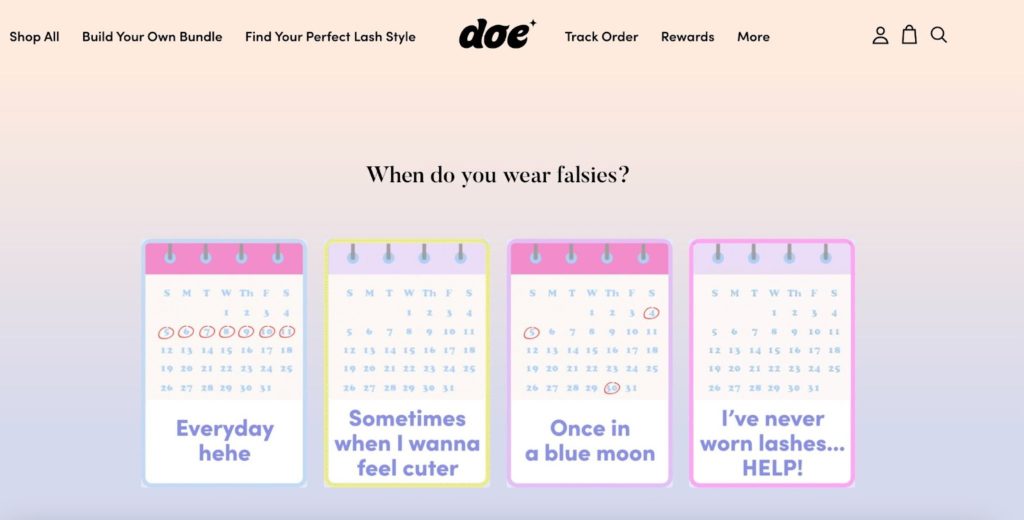
Keep in mind – if your quiz is cool and engaging, people might share it, or it might even go viral!
2. Calculators
Like quizzes, interactive calculators help customize products or services based on their needs. Businesses can use it to provide personalized recommendations, simplify decision-making processes and improve customer satisfaction.
For instance, a furniture e-shop can offer a sofa configurator that lets customers choose the fabric, color, and design options.
Also, interactive calculators are a very common tool for financial institutions, check the loan calculator below:
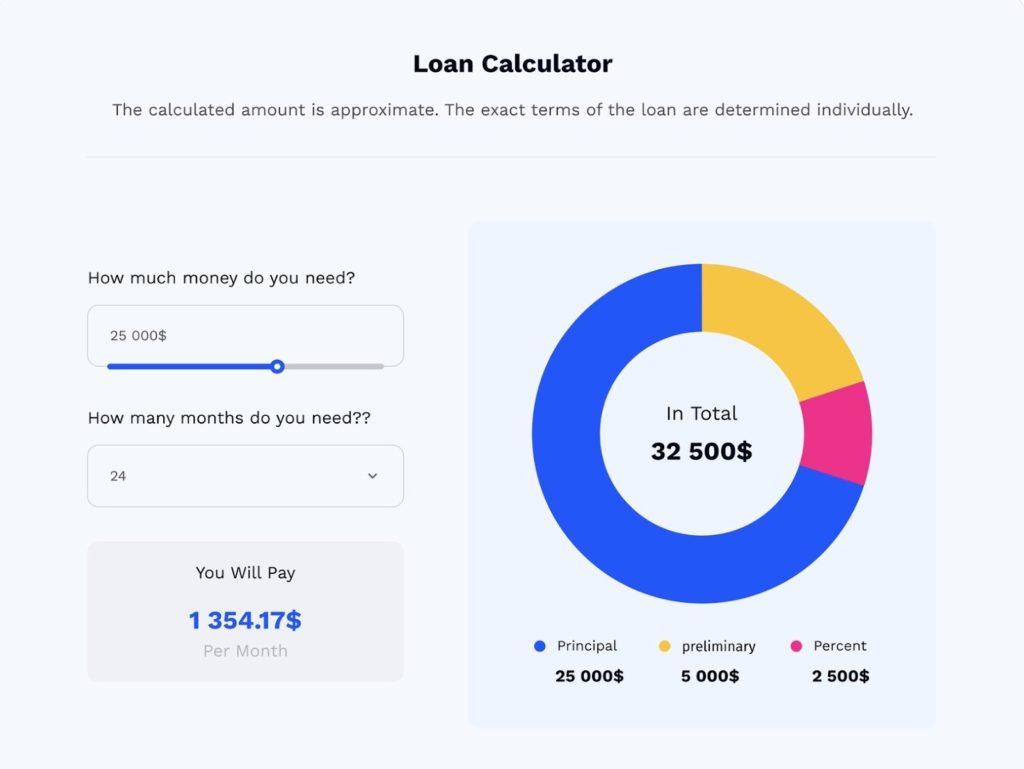
3. Polls and Surveys
Interactive polls and surveys effectively collect your audience’s feedback. They’re essential for marketing research, understanding customer preferences, and gaining insights into your target market.
For example, restaurants can conduct polls to determine customers’ favorite meals, or ecommerce stores can use surveys to understand customer satisfaction and improve their products or service. In short, collected data helps you tailor marketing strategies to serve the target audience better and, ultimately, increase conversions.
Use them on social media, email newsletters, or your website. Check this example of an NPS (net promoter score) survey in an email:
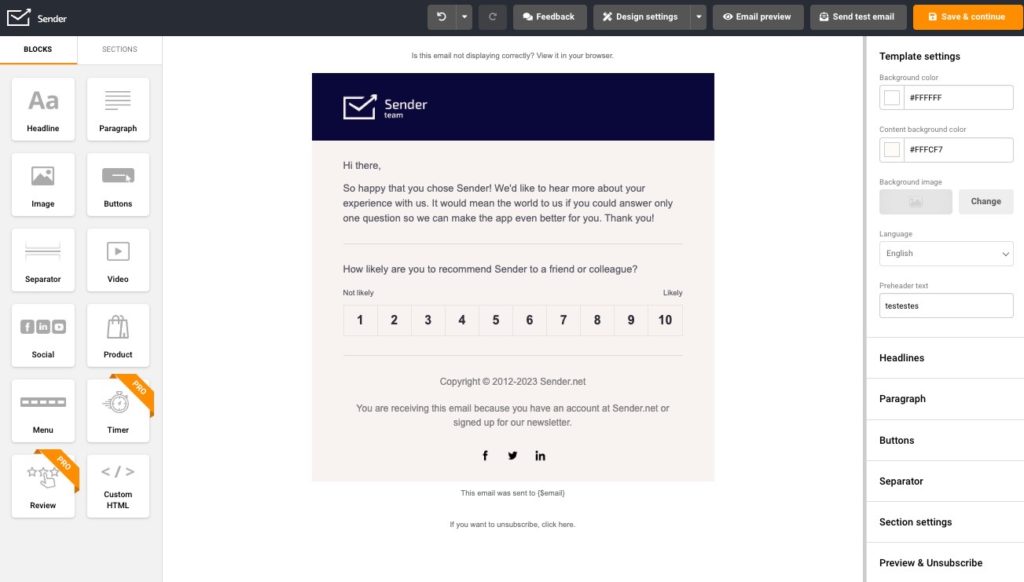
You can easily create such emails with Sender. Premade templates, a simple drag-and-drop email builder, and the review block – that’s all you need!
Also read: What is Interactive Email? AMP, Design Examples & Templates
4. Ebooks
Interactive ebooks enhance the reading experience with multimedia elements such as videos, clickable links, and interactive infographics. They’re perfect for educational purposes, storytelling, and presenting complex information in an engaging and understandable format.
Businesses in various industries can use interactive ebooks to share engaging content, product guides, or industry insights with their audience, keeping them informed and connected.
For example, Sender’s Black Friday marketing guide has a clickable table of content:
5. Interactive Infographics
Transforming static data into engaging visual experiences, interactive infographics, naturally created by an infographic maker, allow users to delve into various sections, obtain further details by hovering over elements, and engage with charts and graphs. Through this format of interactivity, the process flow diagram becomes easier to understand and visually attractive.
For instance, here’s the data breach infographic by David McCandless of Information is Beautiful:
6. Product Recommendations
Ecommerce businesses can leverage interactive product recommendations to offer personalized suggestions to customers based on their preferences and past behavior. You might ask how it works, and it’s not a secret – recommendation engines use algorithms to filter user data. However, if you want to personalize your recommendations to the max, we suggest adding a questionnaire.
One of the most common (and effective!) examples is a “You might also like” section with similar product recommendations. Check the ASOS example:
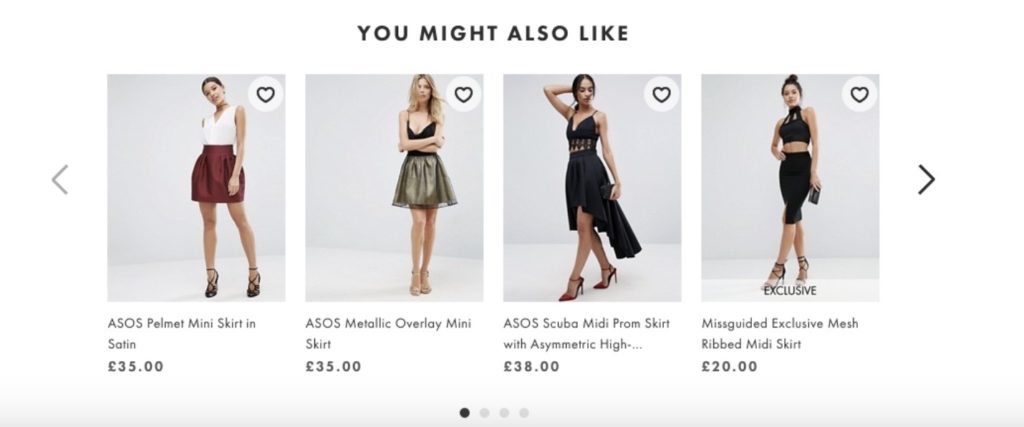
7. White Papers
Interactive white papers differ from traditional text-based reports because they include interactive features like clickable links, charts, embedded videos, and graphs. This approach enables readers to engage with the material by exploring and interacting, resulting in a greater understanding of the information presented.
Interactive white papers include features like:
- Clickable sections
- Embedded videos
- Interactive charts and graphs
- Interactive quizzes or assessments
- Branching paths
- Links to additional resources
8. Landing Pages
Interactive landing pages use interactive features such as quizzes, calculators, dynamic decision tree diagram and forms to engage visitors and obtain useful information. By providing an interactive user experience, companies can enhance their conversion rates, collect lead data, and offer an engaging approach to their products or services.
Interactive elements on a landing page examples:
- Animations
- Quizzes or surveys
- Interactive forms
- Scroll-triggered effects
- Embedded videos
- Sliders and carousels
- Interactive maps
Also read: Free Spin the Wheel Popup — Boost Sales the Fun Way
9. Resource Library
It’s a digital collection of materials, often related to a specific subject, that allows users to engage with the content in various ways actively. Think of resource libraries as digital collections of ecommerce insights. Unlike traditional libraries that hold static materials, an interactive resource library offers dynamic features that enhance the user experience. This can include clickable elements, multimedia components, search and filtering tools, quizzes, and other interactivities.
10. Solution Finder
Solutions finders are designed to assist people in identifying the best possible solutions based on their needs and requirements. Use questions and certain criteria to help them find appropriate solutions or products that best suit their needs. This approach narrows down choices and furnishes personalized recommendations. This, in turn, helps to simplify the decision-making process and leads to end-user satisfaction.
Interactive solution finders typically have elements like these:
- Questionnaires
- Dynamic responses
- Visual aids
- Comparative insights
- Clickable links
11. Interactive Videos
Interactive videos empower viewers to engage with its content using various digital tools actively. Users can click, drag, scroll, hover, and perform other actions similar to how they interact with web content. Interactive videos offer multiple functionalities with common options:
- Hotspots – clickable areas within the video that can lead to external web pages or reveal additional content, such as product prices.
- 360 Views – users can drag the video frame to view in all directions.
- Branches – viewers can choose different paths to customize the content they see, providing personalized navigation.
- Data inputs – users can fill out form fields within the video, like their name or age.
- Quizzes – combining buttons and branching, quizzes assess user’s knowledge and provide personalized results at the end.
12. Interactive Maps
Interactive maps allow users to engage with its content, providing a dynamic and personalized experience compared to traditional static maps. They let people explore geographical information, navigate through locations, and access additional details through a range of interactive features.
These maps often include interactive functionalities like:
- Zooming and planning
- Clickable points of interest
- Filtering and layers (users can toggle between layers of information on the map, helping them focus on specific aspects)
- Customization
- Route planning
- Data visualization
Examples of Interactive Content
1. Spotify’s “Wrapped” Campaign
In 2020, Spotify Wrapped had a significant impact on Spotify’s mobile app downloads, resulting in a remarkable 21% increase in the first week of December. The United States and India accounted for about 33% of global Spotify mobile app users, driving the highest growth in both app downloads and daily active users (DAUs).
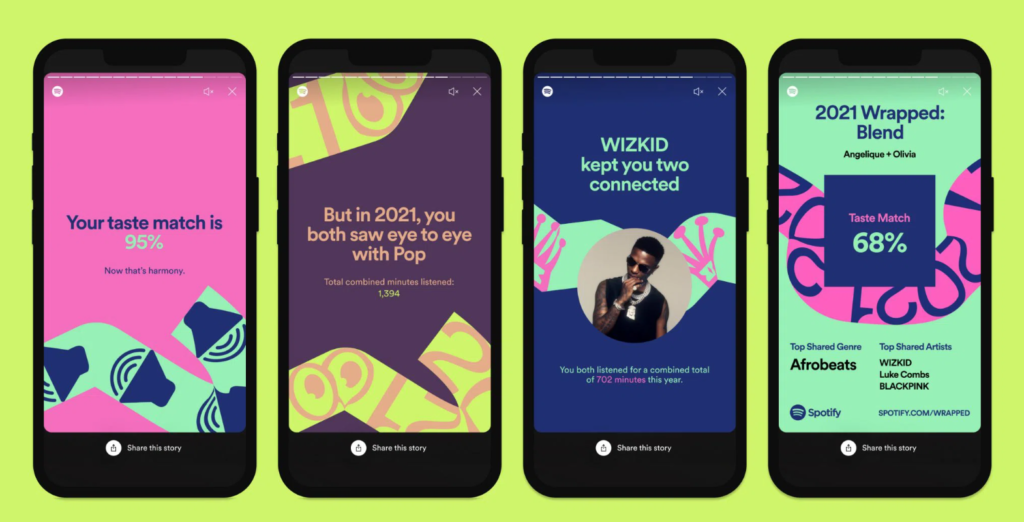
Spotify Wrapped was exclusively available on mobile for Spotify users, while the web experience catered to non-Spotify users. New features, such as in-app quizzes to guess top podcasts, artists, and favorite decade of music, along with the “Story of Your 2020” feature, new Wrapped badges, personalized playlists, and customization options for social sharing, were introduced.
These efforts aimed to enhance user engagement and interactivity, resulting in increased app downloads and a more personalized connection between users and the platform.
2. Unicef’s Coronavirus Facts Quiz :
This quiz from Unicef tackles misinformation on the global COVID-19 pandemic by asking people to see if they can distinguish what the key coronavirus facts really are. It came online in March 2020 and already had over 177K engagements at the time of writing.

This is an important and timely example of how linking to a trending topic can help distribute information that can save lives. The links to more articles about COVID-19 make this quiz an example of how to boost the distribution of extremely important content.
3. FedEx Freight 101 Tool
FedEx Small Business Center has introduced interactive experiences to simplify and gamify the freight shipping process. The Freight 101 tool provides a step-by-step guide, pricing information, and support for opening shipping accounts.
The LTL Freight Classification Tool uses interactive icons to estimate freight class and suggest product solutions. This transition to interactive experiences has streamlined customer education, making it more engaging and enhancing the overall customer experience.
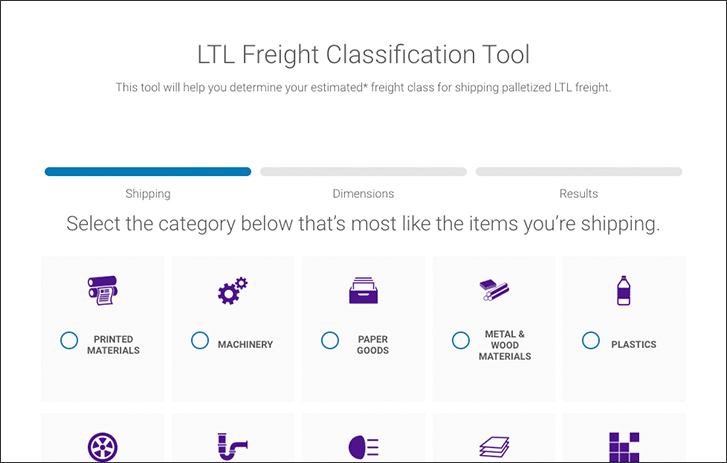
According to Kirkman, the transition to interactive experiences has brought about a simplified customer education process. The main objective, shared by Kirkman and project partner Josh Rosa, was to enhance the customer experience. By introducing interactivity, the process has become more captivating, interesting, and engaging, ultimately leading to increased customer involvement.
The new site has been attracting a large number of users. According to Kirkman, The Freight Box experience alone has garnered 136,000 visits since June.
Additionally, there has been a remarkable 151% increase in Freight Box shipments compared to the six months prior to the page’s existence. The service has also experienced substantial growth, with an average month-over-month volume increase of 86% and an average month-over-month revenue increase of 82%. These statistics indicate the strong success and positive impact of the new site and its offerings.
These statistics showcase the significant impact of interactive content in terms of user engagement, social sharing, global reach, and community building. By incorporating interactive elements into their content strategies, brands can effectively capture the attention of their target audience and create memorable experiences that resonate with users.
Key Takeaways: Interactive Content
If you didn’t have time to read everything, here are key things you must know:
- Interactive content is a powerful approach to capture and maintain viewers’ interest.
- It encourages active engagement with the information instead of passive scrolling.
- User engagement is increased, leading to better absorption of information and stronger brand association.
- Various types of interactive content exist, including quizzes, polls, calculators, and interactive infographics.
- Immersive experiences like virtual reality (VR) and augmented reality (AR) are also examples of interactive content.
- Each type of interactive content offers unique benefits and is suited for different objectives and target audiences.
Also read:
- 12 Tips for Creating Compelling Newsletter Content
- What is Email Content? Definition, Types & Examples
- What is Dynamic Email Content? Definition, Guide & Examples
Author bio
Vinit Sharma is a Growth Marketing Expert and content writer at Venngage Inc, who loves to write on various topics and distribute valuable content over the web.



